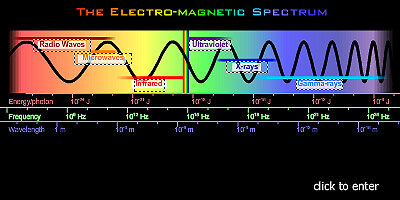The electromagnetic spectrum
Wave radiation
Examples of this type of radiation are around us all the time. You are using it now to read this page, as light is a form of wave radiation. When you listen to the radio, the signal comes via radio waves; when you heat a meal in a microwave oven you are using wave radiation; to become suntanned you expose yourself to wave radiation; if you need an X-ray you expose yourself to wave radiation.
All these different types of wave radiation are related and together are called the 'electromagnetic spectrum’. Humans can only see the tiny part in the middle: visible light, but some animals, such as insects and birds, can see other parts of the spectrum.

Properties of different types of wave radiation
Electromagnetic (EM) radiation is characterised by its frequency (number of waves per second). We can also measure the wavelength of a wave (the distance between two peaks).
Calculating frequencies and wavelengths
The frequency, wavelength and speed of a wave (light) are linked by an equation: c=fλ
where c is the speed of light
f is the frequency
λ, sometimes written as l, is the wavelength
If c is in metres per second m s-1, f is in hertz Hz then λ is the wavelength in metres m
The speed of light in a vacuum is close to 300 000 000 m s-1
The higher the frequency, the shorter the wavelength.

Energy of electromagnetic radiation
EM radiation travels as little packets (quanta) of energy called ‘photons’. The relationship that links the frequency f associated with a photon and its energy E is described as E = h f; where h is a physical constant called the Planck constant, named after Max Planck, one of the founders of the quantum theory.
Each packet of blue light with a wavelength of 470 nm (nanometres – equal to one billionth of a metre) always has exactly the same energy. Photons of red light with a wavelength of 700 nm have a different and lower energy.
Radio waves and the microwave signals from your mobile phone have very low frequencies and so very low energies. Higher frequencies, such as ultraviolet (UV) light, carry much more energy in each photon. The most energetic photons are called gamma rays. One source of these is gamma ray bursts. These are the most energetic flashes of EM radiation from space and the most luminous events known in the universe.
Ionising radiation
From UV upwards (including X-rays and gamma rays) the photons carry enough energy to knock electrons out of their parent atoms by ionising them and so are called ‘ionising radiation’.
This can damage living cells. Too much UV can cause sunburn and in the long term lead to skin cancer. X-rays and gamma rays can quickly produce cancers or even kill cells outright. As a result they must only be used by trained specialists.







